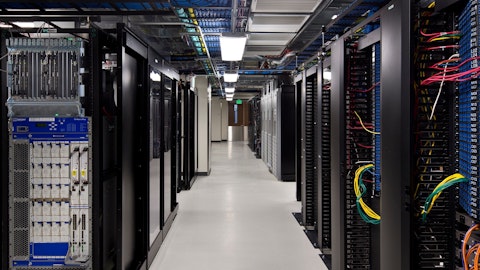Michael Gordon : Sure. Thanks, Tyler. We obviously don’t guide by product, but maybe a couple of things I can say about Q4. First of all, as I mentioned, it was obviously an incredibly strong EA quarter, with EA growing 26% year-over-year. And so as we look out at Q4, it doesn’t make a ton of sense to — as we look at the business, to think that we’re going to meaningfully improve sequentially from an EA perspective, given how incredibly strong Q3 was. And then we talked a little bit on the Atlas side around Q4 doesn’t benefit from the seasonal tailwinds that Q3 does. And so I think on a sequential basis, those are the key factors to keep in mind.
Tyler Radke : Great. And it sounded like you talked about some — certainly some improvements in consumption on Atlas. But if I look at the sequential dollar growth in Atlas in Q3 versus Q2, it was down a bit. Could you just kind of square with improving expansion rates, why would the sequential dollar adds be down? Is it kind of a reflection of new business? Or just help us understand the moving pieces there?
Dev Ittycheria : Yes. I think it’s mostly a reflection of the starting ARR. So you’re basically starting with the compounding slower growth. And so when you think about the entry point, whether it’s Q3 in terms of for the second half of the year or Q4 for the final quarter of the year, you’ve seen several months of slower growth. And so that means at the beginning ARR is lower on an absolute basis. And even if the growth rates were to revert, the number would be lower just by virtue of the fact that the starting ARR is lower.
Operator: One moment for our next question please. And it comes from the line of Fred Havemeyer with Macquarie.
Fred Havemeyer : I was interested also in cloud marketplaces and just kind of a follow-up around that. With the announcement of cloud marketplaces, even today, you’re showing more integration with — for example, today, like Microsoft’s entire data platform. What is it that is drawing these — or what are you doing correctly here that’s drawing these hyperscalers that have their own competitive database offerings to not just sell your product, but potentially partner with MongoDB and provide it through the platform? And then I have a follow-up as well.
Dev Ittycheria : Yes. Fred, I think what that really speaks to is just the power of the MongoDB platform and the product market fit that’s evidenced by how popular we are. I mean we are truly the most popular modern data platform in the world. And so — and a lot of — majority of those users tend to run MongoDB in the cloud. So each of the hyperscalers see a lot of MongoDB usage on each of the clouds. Yes, you’re right. In the early days, they tried more to compete than to partner. And frankly, a lot of people, when we first went public, were skeptical about how we could actually build a cloud business when trying to compete with the hyperscalers. Obviously, we’ve proven the ability to do that. And I think that’s also evidence of the fact that customers are also more discerning, and they’re not just going to take the a la carte in many choice.
They’re going to be very judicious in their evaluation process. And given our — the value we provide, I think you’re seeing the hyperscalers recognize that. And by the way, the hyperscalers also benefit from our growth. They benefit both from the underlying consumption of storage and compute of Atlas as well as that those customers that they win, who are running Atlas workloads in their clouds, then buy other ancillary services themselves. So it ends up truly being a win-win relationship. And I think that’s why you’re seeing the hyperscalers essentially engage with us more deeply.
Fred Havemeyer : And then a follow-up, it’s multi-cloud again related. But I wanted to ask about multi-cloud clusters because I think it’s one of the more unique offerings that you have Atlas out of the box. Just generally, could you help us or just describe where you’re seeing customer adoption trends with your multi-cloud cluster capability and replicase capabilities? .
Dev Ittycheria : Yes. I mean, the trend is — I mean what we’re seeing is there’s a lot of customer interest on this capability. One, depending on the customers’ needs, they could be — they may have a preferred hyperscaler, but they’re expanding into a geographic region where that hyperscaler may only have one region or no regions and they want some diversity across hyperscales in case that region goes down. And so they want the benefit of being able to quickly switch over to another hyperscaler. The other thing that we see is, obviously, as these hyperscalers compete with each other and offer a differentiated set of services, customers want to be able to leverage some services offer in one hyperscaler versus another, even though maybe they’re preferred hyperscaler does not offer such a service.




